Pros
Cons
Introduction
Product Tour
The Panasonic GF1is available in two different kit configurations, both at the same $899.95 price. The more unusual choice comes with a 20mm pancake lens. As the name implies, a pancake lens is nice and flat, a perfect portability combination with the slender GF1. Even more interesting, the 20mm lens (equivalent to a 40mm in 35mm photography) is very fast, at f/1.7, allowing flash-free photography in low light conditions at higher shutter speeds. For test purposes, though, we stuck with the more by-the-book kit, pairing the GF1 body with a 14-45mm f/3.5-5.6 zoom. It's also worth noting that the 20mm lens is not image-stabilized, and doesn't support continuous autofocus.
Front
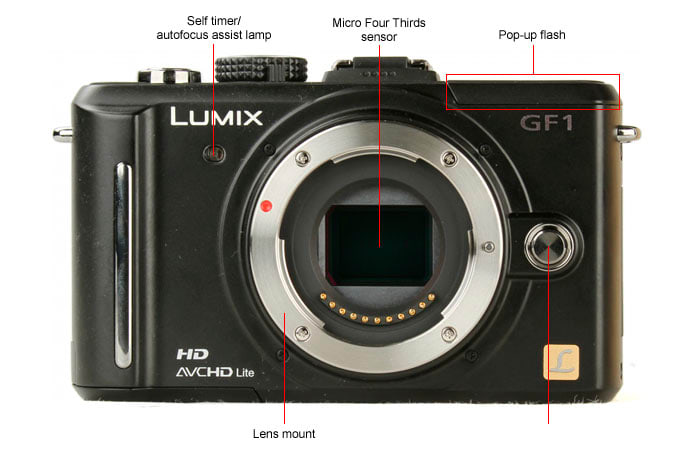
Back
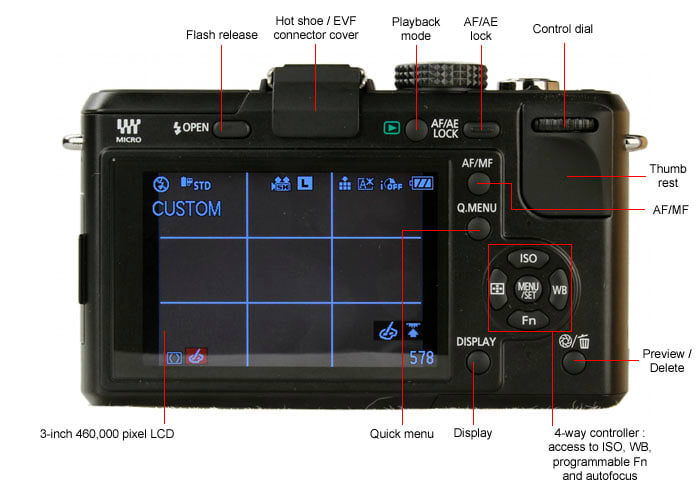
Sides
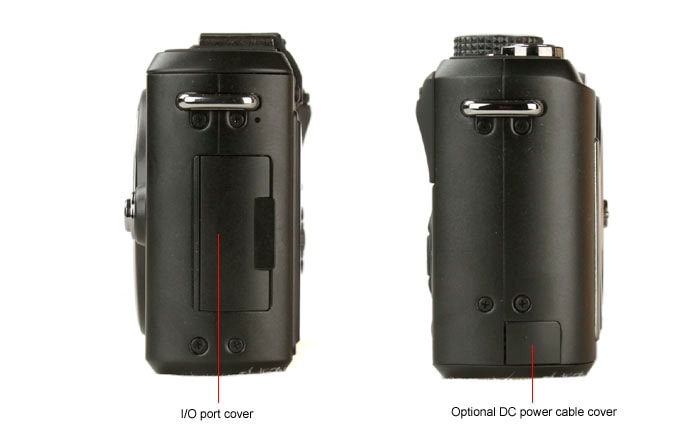
Bottom
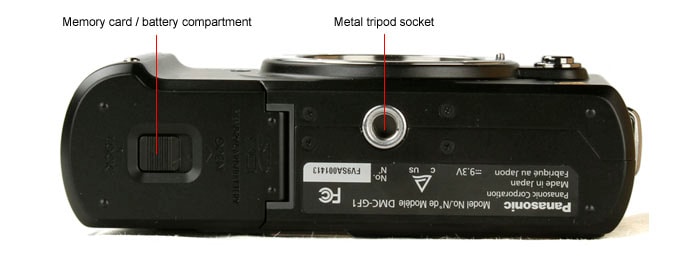
Top
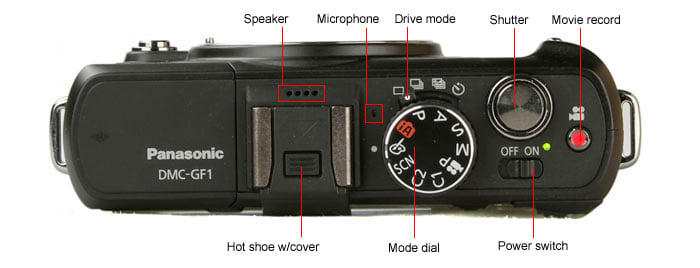
**Size Comparisons **
**In the Box **
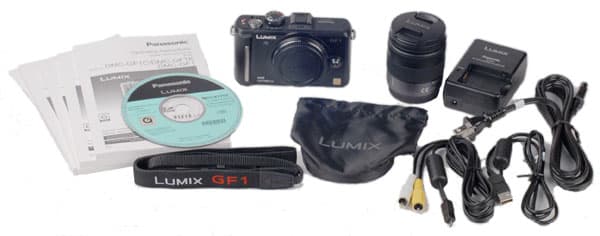
• Panasonic GF1 with body cap
• 14-45mm f3.5-5.6 lens with lens hood
• lens pouch
• Li-on battery
• battery charger
• Camera strap
• AV out cable
• USB cable
• Software CD
• Operating Instructions manuals
• Software installation guide
Color
**Color Accuracy ***(12.38) *
The Panasonic GF1 produced more accurate color than the GH1, but still fared poorly against the Olympus, Canon and Nikon competition. We shoot the X-Rite ColorChecker chart in each available color mode under controlled studio lighting. The resulting images are analyzed using Imatest software to determine which setting produced the most accurate color reproduction. That mode is used for scoring purposes. Click here for more on how we test color.
The GF1 offers nine film modes, six in color and three in black and white. The Smooth mode produced the most accurate results, slightly undersaturated at about 96% and with spot-on hues for the dark skin, foliage, blue flower and purple color patches. However, the yellow and yellow green reproduction were way off the actual color values, with cyan and orange also significantly off.
The following chart shows same size crops of each color patch from the test chart, shot in the most accurate mode for each comparison camera.
NOTE: Because of the way computer monitors reproduce colors, the images above do not exactly match the originals found on the chart or in the captured images. The chart should be used to judge the relative color shift, not the absolute captured colors.
As seen in the chart above, the Panasonic GF1 improves on the color accuracy performance of its brand mate GH1, but still lags the competition overall.
Color Modes*(5.00)*
The GF1 offers nine preset 'film modes,' each of which affects contrast, sharpness, saturation and noise reduction. Six of these presets are in color, as shown in the swatches below, taken from our test shots under studio lighting. There are also three black and white film modes, Standard, Dynamic and Smooth.
Including high-ISO noise reduction settings as part of color mode settings is a Panasonic peculiarity, and not one we favor. It would make much more sense to maintain a separate noise reduction control, as found on most SLRs. It would also be nice to be able to turn off noise reduction altogether, to maximize image detail, but this isn't allowed.
The contrast, sharpness, saturation and noise reduction settings for each preset can be adjusted along a five-step scale. These customized versions can then be stored in one of two My Film slots for future access.
The chart below shows same-size crops from test shots of the ColorChecker chart in each color mode. Dynamic and Vibrant modes were highly oversaturated to produce more dramatic results (112% and 123% respectively), while the Nostalgic mode damps down saturation to about 93.5% for a muted tone. The Nature setting tweaks blue and red reproduction but produces a pretty accurate green value, albeit 10% oversaturated.
NOTE: Because of the way computer monitors reproduce colors, the images above do not exactly match the originals found on the chart or in the captured images. The chart should be used to judge the relative color shift, not the absolute captured colors.
Long Exposure*(6.97)*
In our long exposure test, which analyzes color accuracy and image noise over a range of shutter speeds, the GF1 again shows improvement over the GH1, but still comes up short compared to other cameras. We shoot the X-Rite ColorChecker chart under dim 20-lux illumination at shutter speeds ranging from 1 second to 30 seconds, with long exposure noise reduction on and off, then use Imatest software to determine the camera's performance. Click here for more on how we test long exposure.
Color error is high across the board, with the long exposure filter having little effect. Saturation wasn't bad, hovering around 100% before dipping significantly at the two longest exposure settings, but the color values are off throughout. The chart below shows the level of color error, so shorter bars are better.
Image noise is quite high too and, as we sometimes see, the long exposure noise reduction system makes matters slightly worse. Long exposure noise reduction works by taking a second exposure with the shutter closed, then digitally removing the noise that appears in that second exposure from the image. Problem is, image noise is inherently random, so this approach is hit-and-miss at best.
The GF1 produced better results than the GH1, but comes up short compared to the Olympus E-P1, which also relies on a small Micro Four Thirds sensor, and substantially behind the Canon and Nikon with their APS-C format sensors.
Noise
Noise*(5.26)*
We expect to see Four Thirds and Micro Four Thirds format cameras to produce more image noise than larger-format cameras, due to the small pixel size on the sensor, and the GF1 follows the pattern, with an undesirable level of speckling and artifacts even with bright illumination. It did, however, surpass the results we found when testing the Olympus E-P1. We test for image noise by shooting the X-Rite ColorChecker chart under bright 3000 lux studio illumination at all standard ISO levels and noise reduction settings. In the case of the GF1, Panasonic doesn't allow high-ISO noise reduction to be turned off completely, so we shot at each of the five available levels by adjusting the Film Mode settings. Click here for more on how we test noise.
As seen in the chart below, image noise starts at a high level (around 1%) even at ISO 100, and nearly 1.5% with noise reduction at its lowest setting. Once you get past ISO 800 the noise levels render the images pretty much unusable unless you crank the noise reduction settings up all the way. The good news here, as shown in our sample photos, is that the noise reduction processing doesn't obliterate too much image detail. The good n
This chart shows the relative noise levels of each component: red, blue, green, yellow and luma (grey), with noise reduction at its lowest setting.
Image noise in the blue channel is slightly elevated above the rest, bad news for clean reproduction of those lovely blue skies in your photos.
With noise reduction turned off (or, in the case of the two Panasonic cameras, set to its lowest level), the Olympus E-P1 goes off the rails at high ISOs, while the GF1 performance is still bad, but less awful.
Turning noise reduction up to its highest level, the GF1 outperforms the Olympus E-P1 at high ISO levels, but produces more noise at low ISOs. When compared to the GH1 the situation is reversed: the older camera has lower noise levels at low ISOs, but the GF1 does a better job when the ISO level is raised.
There is a clear divide when comparing scores between the small-sensor and large-sensor cameras in our roundup. The Panasonic cameras score marginally higher than the Olympus E-P1, the Canon and Nikon are a significant step above.
ISO*(5.50)*
The GF1 offers settings from ISO 100-3200. If you prefer finer control, you can set ISO increments to 1/3 stop in the recording menu.
There are two flavors of automatic ISO adjustment, the standard Auto ISO based on light level and an additional Intelligent ISO system that factors in subject movement to boost ISO and shutter speed when called for. In either case, the user can set an upper ISO limit to prevent excessive image noise.
The following same-size crops are taken from photos of our standard still life, taken in aperture-priority mode with automatic white balance.
NOTE: The images above are not used in our testing or scoring, but are included here to show real-world examples of the differences between cameras at the various ISO settings.
Resolution
Resolution*(11.90)*
The Panasonic GF1 did well in our resolution testing, with very good sharpness and low chromatic aberration. We don't include lens distortion in our scoring for interchangeable lens cameras, but we do test it, and the kit zoom lens showed no significant distortion problems. To test resolution, we shoot a slant-line chart under controlled studio lighting, at three different focal lengths, and at three aperture settings for each distance. The resulting images are analyzed using Imatest software, taking into account multiple spots to produce a reliable measure of overall performance, rather than just measuring at the center spot. Click here for more on how we test resolution.
Distortion
We found very low distortion when shooting at the full telephoto distance, and only 0.8 percent at the widest setting and the middle of the focal range.
Chromatic Aberration (9.10)
The image analysis software found a bit of color fringing when shooting at the widest lens setting, but it's inconsequential when viewed with the naked eye.
Sharpness (13.09)
We were impressed with the overall image sharpness of the GF1; even with the lens stopped own all the way, the test results are strong, The best sharpness result was measured in the center of the lens when shooting at the widest focal length. With the lens wide open, we measured 1867 lwph horizontally and 1972 lwph vertically.
The test images shot at the widest 14mm setting (equivalent to 28mm on a 35mm camera) are tack sharp with the lens wide open and still very good even at f/22. There's no appreciable chromatic aberration to be found.
At the halfway point in the focal length range the results are very close to the shots from 14mm.
Close inspection reveals a bit more softness here, particularly with the lens stopped own all the way, but it's still a praiseworthy performance.
The GF1 outscored all the other cameras in our comparison group when it comes to resolution. It's worth noting that the GH1 kit lens is a 10x zoom model, offering a much more demanding resolution challenge. As for the Canon and Nikon results, we were understandably disgruntled with the resolution performance of these two sub-$1000 video-enabled SLRs.
Picture Quality & Size Options*(10.53)*
The options here are generous, with four aspect ratio options, and three resolution settings for each.
There are two compression settings for JPEG images, fine and standard. Shooting RAW files is also supported, either on their own or with an attached fine or standard JPEG image.
Dynamic Range*(5.31)*
Dynamic range test results for the GF1 were slightly better than the Olympus E-P1, but neither camera excelled here. A wide dynamic range means you can take photos in high-contrast situations and maintain detail both in the very bright and very dark areas. The good news here is that the GF1 dynamic range doesn't become severely impaired until you get past ISO 800. However, it starts out low even at the least demanding ISO settings.
To test dynamic range we photograph a Kodak stepchart across the full range of aperture settings, at each available ISO, and use Imatest software to analyze the resulting images. Click here for more on how we test dynamic range.
The following chart shows the dynamic range results for each of our comparison cameras when set to ISO 200. While both the GF1 and the E-P1 fared poorly here, it's interesting that the equally Micro Four Thirds Panasonic GH1 nearly matched the Nikon and Canon results.
Here are the comparative results for the cameras in our test group, again demonstrating that while sensor size is a factor, it's not definitively linked to dynamic range performance, with the Canon T1i turning in mediocre numbers and the GH1 scoring very well here..
Image Stabilization*(2.68)*
Overall, the GF1 image stabilization system, using the kit zoom lens, was unimpressive. It produced marginal improvements at slow shutter speeds with high camera shake, but doesn't measure up to the tested performance of other cameras, including its brand mate GH1.
To test image stabilization, we mount the camera in a custom-designed computer-controlled rig that produces controlled movement patterns. We run separate horizontal and vertical movement tests, each at both a high and low camera shake setting. By comparing the resolution of test images taken with the image stabilization system turned on with those taken with image stabilization off, we can determine the system's effectiveness at reducing blur. Click here for more on how we test image stabilization.
The GF1 uses lens-based optical image stabilization -- the kit zoom lens is stabilized, the kit pancake lens is not. The camera provides three image stabilization modes. Mode 1 employs the stabilization system at all times when the camera is in Record mode, while Mode 2 only uses the system when the shutter button is pressed. Mode 3 only affects up and down movements, allowing for smooth horizontal panning. Only the first mode is available when shooting video.
The image stabilization system has no noticeable effect on horizontal camera shake at low levels (about what you'd expect a two-handed, standing photographer to experience), and some slight advantage combatting vertical shake.
In our tests undertaken under high shake conditions (which you might experience when shooting fast action, or when walking), horizontal shake is less of a problem when shooting at slower shutter speeds. Against vertical shake, the system actually makes matters worse at nearly all shutter speed settings.
The GF1 image stabilization system produces disappointing results when stacked up against the other cameras in our comparison group.
The following actual-size crops taken from our test images demonstrate the resolution results we found at both high and low shake levels, with the camera moving horizontally.
*NOTE: As of May 2010 we have revised our image stabilization testing procedure to consider only horizontal stabilization. The scores shown here are up to date.
*
White Balance
White Balance*(13.51)*
White balance accuracy is a definite strength of the GF1: it outscored all the other cameras in our comparison group by a healthy margin. The automatic white balance system is the strong suit here, with extraordinarily accurate results under often-tricky fluorescent lighting, and very little of that orange tint that seems almost inevitable when shooting with auto white balance using standard household incandescent bulbs.
We test white balance both using the camera's automatic setting and by taking a custom white balance reading under three different lighting conditions. Consistent illumination for test purposes is provided by an X-Rite Judge II lightbox. Click here for more on how we test white balance.
Automatic White Balance (15.33)
The overall results here are exceptionally accurate, with minimal color shift even under difficult lighting conditions. The charts below indicate color error, so shorter is better.
The daylight test shots produced colors that were slightly cool, but it's very unlikely you'd notice the difference in an actual photograph.
Incandescent lighting is the bane of every digital camera, consistently causing higher color error than other types of illumination. For the GF1, though, the shift toward warmer tones is barely noticeable.
The automatic white balance system produced nearly flawless results under fluorescent lighting.
Custom White Balance (11.70)
Taking a custom white balance reading essentially eliminated the already modest warm shift under incandescent lighting, and didn't really make much difference under fluorescent and daylight illumination, which were already pretty spot-on using the automatic white balance system.
The GF1 scored significantly better than the competition here. It's interesting to note that the E-P1 also showed better-than-average performance in our white balance testing.
White Balance Settings*(9.50)*
It's a good thing that the automatic white balance system performed so well, because there are only five presets to use as a fallback. Strangely, this doesn't include a fluorescent option; we often see several fluorescent choices, to compensate for the variety of available bulbs.
The GF1 has two manual white balance slots, so readings can be saved for later use. Taking a reading is fast and easy, with clear on-screen prompts.
The white balance can be set directly in degrees Kelvin, ordinarily a pretty esoteric procedure, but useful here because the Live View display changes as you change the setting the preview the effect of your adjustments. Similarly, preset and custom white balance settings can be finely adjusted along the green-magenta and amber-blue axes, with a live on-screen preview.
White balance bracketing is also available, using the WB fine adjustment system to set the bracketing increments. Three versions of the shot are taken with a single press of the shutter.
Sample Photos
Sample Photos
Still Life Examples
The following photos of our standard still life scene were taken in aperture priority mode, in each camera's most accurate color mode, using automatic white balance. To see the original full-size images in a separate window, click any of the thumbnail images.
NOTE: The images above are not used in our testing or scoring, but are included here to show real-world examples of the differences between cameras at the various ISO settings.
Noise Examples
The chart below shows full-size crops taken from our still life images shot with each comparison camera, at all available ISOs (including extended range settings where applicable).
NOTE: The images above are not used in our testing or scoring, but are included here to show real-world examples of the differences between cameras at the various ISO settings.
Playback
Playback Mode*(10.75)*
You have a nice range of options when reviewing your images on the GF1, including a histogram display, up to 16x image magnification and an easy to use calendar display with images sorted by shooting date.
You can filter the files to be displayed during playback, choosing only stills, movies in either supported format, or pictures taken in particular scene mode categories. In addition to using the calendar view function to find photos taken on a given date, you can use the camera's travel date function to sort through vacation photos.
Photos can be deleted individually, in groups chosen using thumbnails, or all images can be deleted at once.
Movie playback has most of the features we're after, including fast forward and rewind, frame-by-frame movement forward and back, and volume control. The only missing is an easy way to jump back to the beginning of a clip.
The slide show feature is pretty elaborate, in a good way. First off, you have extensive control over what's included: stills and movies, just stills, just movies, photos shot in particular scene modes or on specified travel dates, or only files you've flagged as favorites. There are three different transition effects, and a guitar background track that can be played or muted. It's a major improvement over the barebones capability found on most SLRs, and especially welcome in a camera you can connect directly to an HDTV to show off your handiwork.
In-Camera Editing*(4.00)*
Pictures can be resized to one of the lower-resolution settings available in a particular aspect ratio, handy if you're planning to email a photo. Trimming is also available, but it's limited to a few zoomed sizes and the same aspect ratio and orientation as the original. There is an aspect ratio conversion utility, but it's only used to alter shots taken in 16:9 format.
The Title Edit system lets you create a text overlay that's displayed as you browse your photos, and can optionally be imprinted on your images using the Text Stamp function. It's a one-letter-at-a-time process, not worth the effort for browsing purposes as far as we're concerned, though it might be useful if you want info (about where photos were taken, for example) stamped onto your prints. The Text Stamp function can also be used to imprint the time and/or date a photo was taken, the age of a recognized individual if that's been entered in the camera memory, and the travel date.
There are no in-camera tools to adjust color, brightness or contrast of a stored photo. However, we do like the option to add a brief audio caption to a photo.
Software*(3.50)*
The provided CD-ROM includes two programs, the Photofun browser app and Silkypix, used for image manipulation of both RAW and JPEG files. The flaw here is the lack of Macintosh support, an important omission for Apple aficionados who shoot RAW files.
Direct Print Options*(3.75)*
As expected, the GF1 offers computer-free PictBridge printing to compatible USB-connected printers and Digital Print Order Form (DPOF) file creation, used to give instructions digitally when using an output service.
Hardware
Sensor*(2.00)*
The GF1 sensor has a gross resolution of 13,060,000 pixels and an effective resolution of 12.1 megapixels. The Micro Four Thirds sensor format is both a blessing and a curse. With a compact camera body like the GF1, the fact that the 17.3 x 13mm sensor is nearly 10 times as large as the typical point-and-shoot camera, enabling higher resolutions with lower image noise and wider dynamic range. Conversely, though, if you're comparing a Micro Four Thirds camera against the typical APS-C sensor found in most digital SLRs, image noise is likely to be higher, and the wide angle coverage provided by the same size lens won't be as extensive. When figuring the equivalent optics of a lens in Micro Four Thirds format, you double the millimeter measurements: that is, the 14-45mm lens provided with the GF1 is equivalent to a 28-90mm lens on a 35mm camera. A 14-45mm lens mounted on an APS-C sensor camera, on the other hand, has only a 1.6x magnification factor (roughly 22-72mm), a gain on the wide angle side of the range and a lower maximum telephoto.
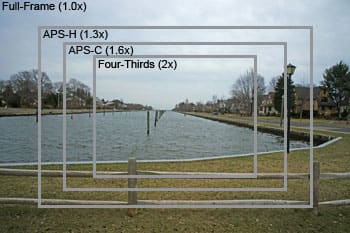
Coverage areas of different sensor sizes compared
The automatic dust reduction system kicks in whenever the camera is turned on, and can also be performed at will by choosing Sensor Cleaning in the Custom menu.
Viewfinder*(0.00)*
The GF1 doesn't come with a viewfinder, but it is compatible with a slick optional electronic viewfinder, priced at $200. The DMW-LVF1 attaches to the hot shoe (a plug slips into a dedicated electronic connection on the back of the camera) and recreates the Live View display in miniature. The viewfinder can also be set at an angle (up to 90 degrees), a benefit of its unusual mounting. This contrasts with the Olympus E-P1, which offers only an optical viewfinder accessory, priced at $100, that displays the scene as it would be seen through the 17mm pancake lens.
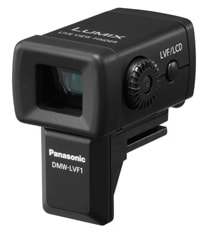
The EVF is a $200 option.
LCD*(6.30)*
The LCD screen is a 3-inch 460,000-dot display that looks particularly sharp when reviewing your shots. It looks fine when shooting in well lit areas, but when the light gets low, the refresh rate gets slow, leading to stuttering and even some blurring as you pan.
The LCD screen (along with the optional electronic viewfinder) can be adjusted to one of seven brightness levels. In addition, there are two optional modes for adjusting screen brightness to fit the shooting environment: Auto Power LCD reacts to detected light levels, while Power LCD turns brightness to full blast, useful when shooting outdoors.
LCD color saturation and color reproduction (along a yellow-magenta axis) also offer seven settings.
LCD Panel
The monochrome LCD found on higher-end traditional SLRs to display camera settings when viewed from above is a rarity even on most consumer SLRs, and absent as expected on this slender Micro Four Thirds model.
Flash*(8.00)*
The GF1 and the Olympus E-P1 are near-twins when it comes to size and shape, but Panasonic figured out how to include a pop-up flash in their compact package, and Olympus didn't. And it's a pretty good little flash at that. Press a button on the back of the camera and it leaps to attention, both above and slightly in front of the camera body, to offer a clearer path past a protruding zoom lens. The autoexposure system can't pop up the flash on its own, which we far prefer; far less likely to accidentally fire off a blast where it's prohibited by regulation or common sense.
Panasonic gives the flash range as 3.28 feet to 5.58 feet (1m to 1.7m) when shooting with the kit lens at its widest setting, at ISO 100. That's not a lot of illumination. However, the flash illumination pattern is surprisingly even, with little of the central hot spot problem we expect to see in a small strobe. Maximum synch speed when shooting in auto flash mode is 1/4000 second, though it's capped at 1/160 second in forced flash mode.
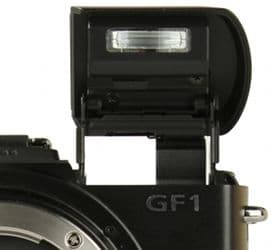
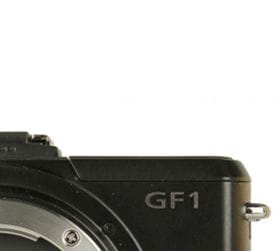
The pop-up flash is well positioned and delivers a nice even burst of light.
All the flash controls you'd expect in a well-outfitted SLR are included here:
When not using red-eye reduction, the flash can be set to second curtain sync, which produces a trailing light effect when shooting moving cars and similar subjects.
Flash output can be manually adjusted, in a ±2 EV range, in 1/3 EV increments.
Lens Mount*(7.50)*
Micro Four Thirds lenses are about 6mm narrower than Four Thirds lenses. Some Four Thirds lenses (along with Leica lenses and others) can be attached to Micro Four Thirds bodies, but only lenses that work with contrast detect autofocus are fully compatible. In addition, even compatibility with lenses produced by fellow Micro Four Thirds supported Olympus have compatibility limitation. At least there's an up-to-date guide to lens compatibility, available at the Panasonic site here.
As for Panasonic's own Micro Four Thirds lenses. there are currently six options, including the two kit lenses available bundled with the GF1 body. We expect most users will opt for the DMC-GF1K package, priced at $899.95, which includes a 14-45mm f/3.5-5.6 zoom lens (equivalent to a 28-90mm on a 35mm camera). There's another intriguing option, though, at the same price: a slender 20mm pancake lens at a speedy f/1.7 maximum aperture. This is a potent combination, particularly those of us who prize portability and low-light capability. Unfortunately, we were unable to get a pancake lens in for testing.
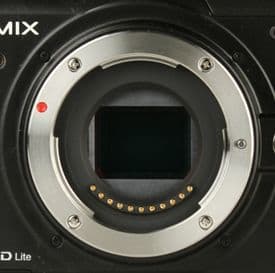
*Micro Four Thirds cameras uses a smaller
lens diameter to enable compact design.*
These three photos demonstrate the actual photographic effect of going from maximum wide angle to maximum zoom using the zoom kit lens.
The GF1 offers two types of digital zoom, neither one of which is especially useful. Extended optical zoom increases magnification when shooting at small and medium image sizes by using only the center portion of the sensor. This doesn't affect picture quality; it's basically the same as cropping down to the center of a full-res image in a photo editing program (but with less creative flexibility). There are also 2x and 4x digital zoom settings, which are the usual quality-be-damned mathematical enlargements and best left unused.
Battery*(7.00)*
The GF1 runs on a DMW-BLB13PP Lithium ion battery rated at 7.2V, 1250mAh. Panasonic gives the number of exposures per charge at 350 pictures, testing according to CIPA standards. This sounds about right to us, and we find this performance impressive, given the constant use of the power-sucking Live View display. Charging time is approximately 155 minutes.
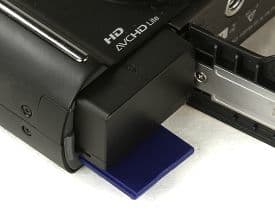
*The battery and SD memory card
share a bottom compartment.*
Memory*(3.00)*
The GF1 is compatible with standard SD and SD/HC memory cards.
Jacks, Ports & Plugs*(6.50)*
Beneath a hinged door on the left side of the camera are three connectors. The round one on top is used for the optional DMW-RSL1 wired remote control ($80). There is no wireless remote available for this camera.
For video output, there's both a proprietary standard-def AV cable connection (at the bottom of the compartment) and a mini HDMI out port (no cable provided) above it. The HDMI output ordinarily switches to match the resolution of a connected TV automatically, but if necessary the user can manually choose from 1080i, 720p or 480p. Panasonic high-def TV owners get a bonus when connected via HDMI: the TV remote can control camera playback.

*HDMI output enables high-def
display of stills and videos.*
Controls
Shooting Modes*(13.00)*
While available shooting modes largely the same as the Lumix G1 and GH1, the GF1 does improve and expand the implementation of the Custom Settings capability. Users can register up to four different combinations of settings by storing the current camera status is one of four available slots (up from three slots in previous models). While the G1 and GH1 had only a single mode dial position for accessing these custom settings (you had to decide beforehand, via the menu system, which stored profile would be assigned to this position). The GF1 provides two mode dial spots, one always pegged to the first custom settings profile, the second selectable from the remaining three options.
The movie controls have also changed from the GH1, which provides full control over shutter speed and aperture settings in Creative Motion Picture mode. The GF1 offers Motion Picture Program mode instead, which provides manual aperture setting for depth of field control plus exposure compensation.
Live View*(4.25)*
The Live View screen comes in two user-selectable layouts (via the custom settings menu), which aren't really all that different. The LCD monitor style display offers two views (toggled by pressing the Display button)/ One shows a top-and-bottom information overlay, the other has no overlay at all. The alternative, called Viewfinder style, shrinks the Live View image slightly to make room for a black bar at the bottom (as seen through a typical SLR viewfinder) with core settings overlaid in white, and a second information readout at the top, which is turned on or off by pressing Display.
The two views provide slightly different information displays while shooting. In the LCD monitor style, you can show the shooting information overlay or choose an entirely clean screen. The Viewfinder style offers two levels of information display detail, but you don't have the option to remove the overlay completely.
The illustration below shows the information arrangement when shooting with the LCD monitor display style.
We found the ability to superimpose a variety of guide line patterns on the Live View display very valuable. While the relatively straightforward 3 x 3 grid pattern got the most use, two other options are also available. One uses a 4 x 4 grid plus diagonal lines that cross at the center, helpful for pinpointing the middle of the image. Another alternative superimposes just two lines, one horizontal, one vertical, but lets you move those lines anywhere on screen you please using the four-way controller buttons.
Yet another Live View option is a luminance histogram overlay (it's an either-or choice between guide lines and histogram display). Fortunately, the histogram can be moved around on the screen easily, using the four-way controller, so it won't obscure a key part of the scene.
Scene Modes*(6.83)*
For the GF1, Panasonic cut the extensive scene mode selection available on the GH1 (with an exceptionally generous 25 choices) down to a more modest 16. Peripheral Defocus is a new choice, allowing users to select a focus point (including off-center subjects) and have the camera set a shallow depth of field, with the selected subject in focus and the background blurred.
Picture Effects*(4.50)*
The GF1 offers nine preset film modes, six in color and three in black and white. For color, these include Standard, Dynamic, Nature, Smooth, Nostalgic and Vibrant; for black and white there are standard, dynamic and smooth. We have samples of the same scene shot in each of these modes in the Sample Photos section, in the Film Mode Examples.
Each color preset mode can be adjusted for contrast, sharpness, saturation and noise reduction, with five steps for each setting. The black and white modes work the same way, except there is no saturation control. Having noise reduction as a film mode setting rather than an overall camera setting is an odd choice, making changes less convenient than the more typical procedure. You're also prevented from turning off noise reduction completely, as we often do when trying to tease out as much image detail as possible. Considering the fact that the GF1 uses a Micro Four Thirds sensor, which are typically noisier than the common digital SLR APS-C format sensor, it's understandable that the company would encourage users to use noise processing, but it shouldn't be a requirement. At the same time, we have to admit that the algorithm used by Panasonic produced far less detail loss than we expected.
Multi Film bracketing is an interesting feature that lets you select two or three different Film Mode settings and take shots in each one consecutively. Unlike white balance bracketing, you don't take a single shot and have it saved in different versions: in this case, you'd have to press the shutter repeatedly or set the camera to burst mode.
My Color mode, a newbie-friendly feature found on the G1 and GH1 has been improved with the GF1. In the earlier version, the user gets to set color, brightness and saturation, each along an eleven-step scale, with the results previewed interactively on screen (as you'd imagine, this substitutes for Film Mode settings). These options are still available by choosing Custom when the mode dial is set to My Color, but there are also seven presets that work much like the artsy filters found on Olympus and Pentax cameras. The My Color settings can be applied to still or video shooting.
We've illustrated six of the My Color settings in the chart below, with Panasonic's own, sometimes strangely poetic explanation of the effect provided.
To demonstrate the Silhouette preset required a different type of shot. As seen below, the photo on the left maintains some color and detail when shot in program mode. Switching to the Silhouette setting in My Color simplifies the image, emphasizing the geometric shapes by eliminating gradation between values.
Focus*(19.00)*
Autofocus performance has been a key strength of the Lumix G series from the start, and this continues with the GF1. The Live View autofocus on most digital SLRs is too slow to be practical when shooting moving subjects. Panasonic, though, has figured out how to make contrast detect autofocus nearly as fast as the standard SLR phase detect system, and certainly workable for all but the most sports-oriented photography. This is an area where the GF1 has a clear advantage over the Olympus E-P1, which suffers from pokey autofocus speeds.
The continuous autofocus in video mode pioneered on the GH1 is also implemented on the GF1, though without the single 10x lens super-quiet the company provides as the GH1 kit lens, you may pick up some focusing noise while shooting in continuos autofocus mode.
The autofocus system supports four modes:
It is also possible to select between AF-S (autofocus single) and AF-C (continuous) modes. AF-S focuses when you press the shutter halfway and maintains that setting, even if you move the camera. AF-C keeps refocusing as necessary while you hold the shutter down, even if your subject moves, or you move the camera. Yet another set of autofocus options are prefocus settings, available through the custom settings menu. Here you can choose from Q-AF (Quick Autofocus), which tries to autofocus whenever the camera is held still, and C-AF (Continuous Autofocus), which attempts to maintain focus at all times, even if the camera is moving and your finger is nowhere near the shutter button, with compatible lenses. Confusing terminology rules here (having both Autofocus Continuous and Continuous Autofocus as distinct choices isn't playing fair), but you do get a lot of flexibility to handle different shooting situations. Of course, using the prefocus modes is going to result in a significant battery life hit.
There's a bright red autofocus assist lamp on the front left, right below the LUMIX logo, which does a nice job when the lights are low. However, the positioning isn't perfect. It's very easy to cover up the lamp with your right middle finger while shooting, especially if you have large hands.
And, of course, there's manual focus mode, chosen via an on-screen menu selection rather than a control on the lens. By default, a zoomed-in view of the scene (up to 10x magnification) appears when you start focusing manually, returning to normal view when you depress the shutter button halfway. In certain circumstances (when shooting on a tripod, for example) we found this useful, though having the rest of the screen disappear while trying to manually focus on a moving subject is less practical. You can also set the camera to allow fine manual focus adjustment after the autofocus system has done its business.
Panasonic continues with its odd variant to face detection, which it calls face recognition. You can register up to six faces in the camera's built-in memory, complete with name, birthday and a priority rating if you choose. Then, when the feature is turned on during shooting, those registered faces will be given preferential treatment when focusing and setting exposure. The name can even be displayed on screen, for no apparent reason. The face recognition concept does have some interesting benefits, though. When taking group photos (at a school concert, for example), it will help make sure your little darling is in focus rather than some random kid. And during playback, it's possible to view only images which include recognized faces.
Exposure*(5.50)*
The exposure compensation range is ±3 EV, in 1/3 stop increments. Accessing exposure compensation is easy: click the rear control dial, then turn it to enter an exposure compensation setting. You don't have to hold down a button when changing this setting, a definite plus. And while the original G1 dial was easy to click accidentally, pressing the GF1 control requires enough oomph to solve this problem. Exposure comp is also available through the quick menu system.
The exposure bracketing system is unusually flexible. with your choice of a 3-, 5- or 7-shot sequence at intervals of 1/3 or 2/3 EV.
Panasonic calls its dynamic range adjustment system Intelligent Exposure, abbreviated i.Exposure. There are three adjustment levels available, offering increasingly aggressive processing of high-contrast images at the expense of increasing image noise.
Speed and Timing
Shot to Shot (3.30)
Panasonic promises a top burst rate of 3 shots per second. Our lab tests surpassed these expectations, delivering a solid 3.3 shot per second performance, making it a respectable contender within the consumer SLR market.
Drive/Burst Mode (6.50)
The GF1 supports two burst mode settings: High at 3 frames per second and Low at 2 frames per second. When the camera is set to AFC mode, the camera will adjust focus between shots, cutting the burst rate.
Depth of Field Preview*(3.00)*
With so many midrange SLRs dropping depth of field preview altogether, we're pleased to see Panasonic has not only come up with a very effective implementation of the feature, but added a unique shutter speed preview as well. Pressing the Aperture/Image Delete button while shooting stops down the lens to the current aperture setting, so you see what will actually be in focus when you take the shot. If you then press the Display button it takes you to shutter speed preview mode, which displays a series of images sequentially to preview the level of blur there would be in your photos if you shot at current settings. It's an interesting interactive way to figure out how to stop the action (of whirling ceiling fan blades, for example), or capture the degree of blurriness you want for artistic effect.
Metering*(8.60)*
The GF1 uses a 144-zone metering system, with three available modes:
An exposure meter display can be overlaid roughly two thirds of the way down the Live View screen, displaying shutter speed and aperture horizontally.
Shutter Speed*(10.00)*
Available shutter speeds range from a 1/4000th second to 60 seconds, plus bulb exposure to a maximum of four minutes.
Self-Timer*(3.50)*
In addition to the basic 10-second and 2-second shutter delay options, you can also choose to have three consecutive shots taken after a 10-second delay, handy if you're racing to get into the photo.
A wired remote, the DMW-RSL1, is available for about $20. The GF1 doesn't support a wireless remote control.
Other Features*(1.00)*
Audio Recording
The mic can be used to record 5 seconds of audio along with a photo. This is a useful feature when you want to make a note about the shooting situation without fumbling for a pen and paper. Audio annotations can also be added during image playback.
Design & Handling
Handling*(9.00)*
It's a pleasure to shoot with the GF1, and a pleasure to carry it along too. With the 20mm pancake lens attached, the camera will fit easily into a jacket pocket or purse. And even with the 14-45mm kit lens, you won't eat up much space in a shoulder bag or backpack when traveling with the GF1. With the pancake lens attached, the whole package weighs in at just under a pound (15.6 oz. / 442g), and even with the zoom it's still a lightweight18.9 oz. (537g). By way of comparison, the GF1 body is 25% lighter than the Olympus E-420, the smallest digital SLR on the market.
Fortunately, the compact size presents only one significant handling problem. The right front has a rounded, slightly raised grip with a silver insert providing a little extra traction. We would have made this grip a bit deeper, but it's fine the way it is. There's a nice curved thumb rest on the back, with a substantial top ridge that effectively keeps your thumb from drifting over to the control dial mounted above it. Our only concern is the location of the autofocus assist lamp, on the front of the camera, below the LUMIX logo. We frequently found our middle finger completely or partially covering this lamp; it takes a concentrated effort to avoid it, which is one more thing to think about when shooting in low light.
The camera construction feels solid, the buttons have a pleasing clickiness, the dials move with precision. There's a dedicated movie record button on the far right on the top, available for instantly taking advantage of video shooting opportunities without having to spend time turning the mode dial. This button was located on the back of the GH1, easy to press accidentally. We had no such problem with the new top-mounted position. Another problem with previous Lumix Micro Four Thirds cameras, an overly sensitive control dial that's easy to click and turn accidentally (changing the exposure compensation settings in the process) was improved in the move from the G1 to the GH1, and really eradicated with the GF1.
Controls*(10.25)*
In the past, we've had complaints about some of the G-series camera controls. Specifically, the single control dial can be clicked for direct access to exposure compensation settings. On the G1, we frequently clicked this control accidentally, leading to lots of poorly exposed shots. On the GH1, the dial click was made stiffer, lessening the problem. This time out, Panasonic has solved the problem entirely.
Our other problem was the movie record button the GH1, which was for all practical purposes part of the thumb rest and just aching to be pushed by mistake. This time out the control has been moved to the top of the camera, out of harm's way without sacrificing instant access convenience.
Menu*(7.00)*
The GF1 offers direct access to several key shooting controls, including ISO, white balance and focus mode, via buttons on the back of the camera. Most of the other frequently changed settings in record mode, including film mode, image size and flash control, are a single button-press away, via the Quick Menu system (which has its own dedicated button). The Quick Menu system makes the information overlay on the Live View screen interactive, navigable with the control dial or four-way controller. To change a setting, you press the Menu/Set button.
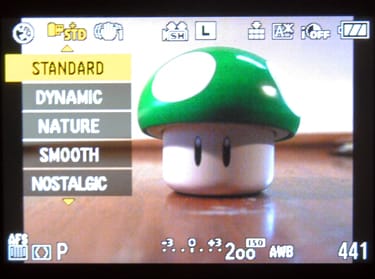
*The quick menu system overlays key shooting
controls on the Live View display.*
For the remaining settings, there's a typical multipart menu system. The menus are easy enough to read, color coded for quick identification, and settings include both icons and legible text, so you're never stuck guessing what a line item controls. However, each menu can run up to five screens deep, meaning a lot of scrolling and searching before you find what you're after.
Manual & Learning*(4.50)*
The 204-page Operating Instructions manual isn't bad, but it has its peculiarities. For example, before even telling you how to hold the camera or take your first picture, there's a detailed presentation of every obscure option in the setup menu. And don't go looking for 'video' or 'movie' in the index -- that's 'motion picture' to you. On the plus side, there are plenty of illustrations, the scene mode settings are explained (which is often skipped in user manuals) and while the writing and presentation can get a bit dense at times, all the information you need to use the multitude of camera features is in here somewhere. To see for yourself, you can download a pdf file copy of the manual here.
Video Color & Noise
**Video: Color Performance***(9.11)*
The Panasonic GF1 did a good job in our video color testing. The camera registered a color error of 3.84, which is better than average for a video-capable DSLR, and its saturation level was a decent 85.2%. In bright light, we saw very little difference in terms of color accuracy when we used the GF1's MJPEG record setting vs. its AVCHD Lite compression. The specific numbers mentioned above were from our MJPEG test (with AVCHD Lite the GF1 managed a 3.93 color error with 86.39% saturation). Click here for more on how CamcorderInfo.com tests color performance.
The GF1 has a variety of color modes that are available for use in video mode as well as with still photos. Some of these color modes are shown below. The camcorder produced the most accurate colors in regular auto mode with the Standard color setting.
Below, you can see the GF1 captured a very similar image to the GH1, which makes sense because they are both manufactured by Panasonic. The Olympus E-P1 didn't have very good color accuracy in this test (a 7.28 color error), and the Nikon D5000 produced an overexposed image (although, with good color accuracy).
Interestingly, the Panasonic GF1 did capture colors a bit differently depending on whether you shot using the MJPEG or AVCHD Lite settings. AVCHD Lite produced slightly darker colors than the MJPEG compression, but both options had very similar color accuracy and saturation levels. In our other testing, however, we saw more significant differences when switching between the two compressions (particularly in low light).
**Video: Noise Performance***(12.28)*
The GF1 did very well in our video noise test, which is the norm for DSLR cameras that shoot video. The camera averaged just 0.355% noise—statistically identical to what the Panasonic GH1 measured. In our bright light testing, we noticed little difference in noise levels whether we shot using the MJPEG or AVCHD Lite settings on the GF1. Click here for more on how CamcorderInfo.com tests noise performance.
Since all the cameras shown above did very well in our noise test you can't really see much noise in the crops above. The Olympus E-P1 shows some signs of noise (in its brown patch), as it had the most noise of the set. The crops above also allow you to get an idea of how sharp an image each camera is capable of producing. The Panasonic GF1 does a pretty good job with sharpness despite the fact that it captures at a maximum video resolution of 1280 x 720. The Olympus E-P1 and Nikon D5000 also max out at 1280 x 720, while the Panasonic GH1 is the only camera in this group that has a 1920 x 1080 recording option.
Video Motion & Sharpness
Video Low Light Performance
**Video: Low Light Sensitivity***(0.66)*
Low light sensitivity is not one of the Panasonic GF1's strengths. The camera needed 25 lux of light to reach 50 IRE on our waveform monitor when we shot using its 30p frame rate (MJPEG compression), and it required 29 lux of light to reach the same levels when shooting at 60p (AVCHD Lite compression). These numbers aren't that much worse than what we've seen from other video-DSLRs, but they are worse nonetheless. Click here for more on how CamcorderInfo.com tests low light sensitivity.
A lot of factors go into determining low light sensitivity—ISO settings, lens specs, sensor size, and pixel count just to name a few. The GF1 has a fairly fast, f/1.7 lens, which is why we're surprised to see it have such a poor low light sensitivity in video mode. In video mode the camera sets ISO and shutter speed automatically, so you cannot use a slow shutter to boost performance in low light.
**Video: Low Light Color Performance***(7.91)*
Despite its sub par performance in our sensitivity testing, the GF1 did quite well with low light color accuracy. The camcorder earned a color error of 4.52 in our low light testing, with an excellent saturation level of 93.29%. We got these numbers by testing the camcorder using its 30p MJPEG mode. Using the AVCHD Lite 60p record setting, the GF1 had worse color accuracy (5.4 color error), but the same saturation level (93.29%). Click here for more on how CamcorderInfo.com tests low light color performance.
As we saw in our bright light testing, the GF1 produced a very similar image to the Panasonic GH1. Both cameras had strong, saturated colors, and the two earned nearly identical color error scores. All the cameras shown below did relatively well with this test, with none outperforming the rest by a significant margin. As you can see, the Nikon D5000 produced the brightest image, which means its auto exposure system is calibrated a bit differently than the rest of these models.
**Video: Low Light Noise Performance***(9.25)*
The Panasonic GF1 averaged 1.2775% noise in our low light testing. This is a pretty low amount of noise, but both the Nikon D5000 and Panasonic GH1 did even better in this test. The Olympus E-P1, on the other hand, had a lot of noise in its low light image (2.2775%). The Panasonic GF1 produced slightly less noise when we shot using its AVCHD Lite 60p setting. Using that mode it managed 0.9575% noise—a roughly 0.3% reduction from our MJPEG 30p testing. Click here for more on how CamcorderInfo.com tests low light noise performance.
Notice how much cleaner the GH1's image looks compared to the GF1 in the crops above. The GF1 has more noise and some patches of discoloration, while the GH1 offers a sharper, more pristine image. The crop from the Olympus E-P1 shows off its noise issues quite clearly as well.
Video Features
**Video: Compression***(0.00)*
The Panasonic GF1 offers two compression options for video: Motion JPEG (MJPEG) and AVCHD Lite. MJPEG compression is commonly found in digital cameras and it is popular on video-capable DSLRs as well. The codec has been around for a while and it is compatible with most media players and editing programs. For these reasons, Panasonic recommends you shoot MJPEG if you plan on working with or viewing your footage on a computer.
The AVCHD Lite compression is an off-shoot of AVCHD, which is used on nearly all consumer HD camcorders that don't record to tape. In theory, there isn't much of a difference between AVCHD and AVCHD Lite—the 'Lite' variety simply tops out with a 1280 x 720 resolution. Interestingly, however, we noticed a number of editing programs having difficulty dealing with footage shot using the AVCHD Lite compression on the GF1. Final Cut Express imported the AVCHD Lite footage with no problem, but the clips ran at double speed when we played them on a computer. The same thing happened when we imported the footage using iMovie and Adobe Premiere. Since AVCHD Lite is so new, it seems many editing programs have yet to provide plug-ins or updates to handle the compression system. According to Apple, the newest version of iMovie HD should work with AVCHD Lite.
The GF1 records video at a maximum resolution of 1280 x 720 (available in both MJPEG or AVCHD Lite). The MJPEG option records video with a 30p frame rate, while AVCHD Lite uses a 60p frame rate (the sensor output is 30 frames per second, however). This 60p frame rate with a 30p sensor output is probably the main reason certain editing programs had difficulty playing back the footage at the correct speed. Strangely, the Panasonic GH1 had the same setup for its 60p mode—and we had no trouble dealing with the footage captured by that camcorder.
The Panasonic GF1 has numerous quality and resolution options for recording video. The table below lists all the available recording options:
**Video: Manual Controls***(5.50)*
When shooting video with the Panasonic GF1 most of the camera's controls run automatically. ISO and shutter speed can never be set manual for videos, but the camera does allow for limited aperture and exposure adjustment. You can shoot video with the GF1 in any mode, including scene modes and Intelligent Auto (iA) mode.
If you want to control aperture in your videos you can only do so in Motion Picture P mode on the GF1. In this mode you can control exposure and something Panasonic calls 'peripheral defocus,' which is essentially aperture control, but with a different name.
Auto Mode
Intelligent Auto mode enables the GF1 to automatically select a scene mode it feels is applicable to your shooting situation. In video mode the GF1 will either set itself to i-Portrait, i-Scenery, i-Low Light, i-Macro, or a standard setting if none of the scene modes apply. We didn't find this intelligent scene selection to be all that useful in video mode. More often than not it worked better to just select a scene mode ourselves.
When shooting video in Program mode (P), Aperture-priority (A), Shutter-priority (S), or Manual mode (M), the camera will automatically set aperture and shutter speed (you can adjust exposure, however). It doesn't matter what you set the shutter or aperture to in these modes—once you press the video record button the camcorder will automatically select its own settings.
Auto exposure worked quite well on the GF1 and we found it to transition nicely from different light sources. The camera has a couple of different autofocus options, which we discuss in more detail in the *Focus *section below.
Zoom Controls and Zoom Ratio
The kit lens for the GF1 is a 14-45mm f/3.5 - f/5.6 Micro Four Thirds lens. The kit lens doesn't provide the longest zoom (roughly a 3x optical zoom), particularly when compared to traditional HD camcorders (usually 10x - 16x optical zoom). Zooming is performed by rotating the zoom ring on the lens—and yes, the camera's built-in speaker picks up plenty of noise associated with adjusting the zoom lens.
The GF1 also has a 2x and 4x digital zoom option that can be used in video mode.
Focus
The GF1 does have a live, continuous autofocus in video mode, but it is much slower than a regular camcorder. Subjects often took 4-5 seconds to come into focus and the transition was gradual and smooth. Some may like the slow transitional focus performed by the GF1, as it offers a very different aesthetic to the quick, snap-like focus found on many consumer camcorders.
You can also set focus by pressing the shutter button down halfway, just as you would when shooting photos. Manual focus is adjusted by rotating the focus ring on the camera's lens. Unfortunately, you cannot adjust focus manually in video mode unless the camera is set to manual focus only. There is no option for simultaneous auto/manual focus when shooting video—you must choose one or the other.
Exposure, Aperture, and Shutter Speed
Exposure can be adjusted in most modes and you can even adjust the levels during recording. Exposure is set by rotating the small dial on the back side of the camcorder (in the upper right).
Aperture can be manually set on the GF1, but it is called peripheral defocus and you can only adjust the setting in Motion Picture P mode. You set the peripheral defocus by rotating the same dial that is used to adjust exposure. The camera allows you to switch between exposure and aperture adjustment by pushing in on the dial.
Our main problem with the peripheral defocus option is that the camera doesn't tell you what f-stop values you are actually setting the camera to. Instead, a bar-display appears on the LCD with one end showing a blurred background with an in-focus foreground and the other end showing both the foreground and background in focus. With this, you adjust the peripheral defocus to produce the desired depth of field effect. This system may be easier for beginners to understand, but pros will definitely be perturbed by the fact that there is no numeric display of f-stop values in video mode.
ISO and Other Controls
Since the GF1 doesn't offer shutter speed or ISO controls in video mode the only other manual controls worth talking about are the camera's color modes. The GF1's color modes work in video mode just like they do for still photos. You can choose one of the pre-set options or you can make your own custom color setting.
The GF1 also has a flicker reduction setting that is meant to reduce flicker caused by fluorescent lighting in some areas. With flicker reduction turned on the shutter speed is locked at 1/100 of a second and peripheral defocus cannot be adjusted.
The Panasonic GF1 doesn't have much in the way of audio features. The GF1's built-in mic is tiny, located on the top of the camera, and only records monaural audio. You can also expect the mic to pick up noises associated with the camera's functions—rotating dials, focus/zoom motors, etc. Simply put, don't expect to be able to record quality audio with the Panasonic GF1.
The camera does have one audio feature, Wind Cut, that attempts to reduce noise associated with rustling wind. There are some video-capable DSLRs that offer built-in stereo microphones, as well as a few that have external microphone inputs. See the table below for more details:
The Panasonic GF1 is small, like the Olympus E-P1, but that's about all it has going for it as far as being well-designed for shooting video. The camera has no electronic viewfinder and its LCD is entirely stationary. Nothing makes a camera worse for shooting video than having a stationary LCD. You can't rotate the screen for shooting at odd angles, nor can you tilt it to avoid glare. When framing a subject, often times you must squat or contort your body in a certain manner just so you can view the LCD. While this may be feasible if you're only taking a few snapshots, it is not ideal conditions for shooting lengthy videos. On a positive note, the GF1 does have a very large LCD, so it is easy to see what's going on—as long as you have a good view of the screen.
In addition to the stationary LCD, the GF1 also doesn't offer the best grip. The camera is much lighter and smaller than most DSLRs, but it doesn't have a bulge on its right side that you can really wrap your hand around. Also, as we say with all video-capable DSLRs, if you're used to shooting video on a traditional camcorder the Panasonic GF1 is going to feel downright awkward as a video capturing device. It simply isn't shaped like a regular camcorder. Now, if you're accustomed to using DSLRs—particularly compact ones like the GF1—you may not be bothered by the GF1's design.
We should give kudos to Panasonic for keeping the video mode on the GF1 very simple. In fact, the camera's video controls are probably too simple for most users. Only aperture and exposure can be adjusted on the camera, so don't seek the GF1 if you were hoping to play around with shutter speed and ISO controls in video mode (white balance can also be set manually in video mode). We are upset by the fact that Panasonic calls aperture control 'peripheral defocus' in video mode and that the camera doesn't list f-stop values when you adjust the aperture. This, however, is part of the camera's simplicity, and it may intrigue users who simply want a video mode that is easy to play around with.
Olympus EP1 Comparison
Performance
These two Micro Four Thirds models aren't radically different when it comes to performance, but there are a few noteworthy strengths and weaknesses. The E-P1 delivered far more accurate color reproduction and superior long exposure results. The GF1 was superior in white balance and dynamic range testing (a particular weakness of the E-P1), slightly bested the E-P1 in the resolution category where both are strong, and offers faster shot to shot speed. When shooting video, the GF1 delivered better color accuracy and lower noise.
Components
These are both solidly build, substantial cameras. The GF1 does have a few key advantages, though, starting with a higher-resolution LCD and a pop-up flash that worked well. The GF1 also supports an electronic viewfinder and, while it's unfortunately a $200 option and not a standard-issue component, at least those of us who like to hold the camera up to your eye while taking a photo can acquire this capability. We do admire Olympus' ingenuity when it came to designing a compact lens to go with their slender camera design. The 14-42mm kit lens can actually be collapsed down when not in use, saving roughly an inch in depth that enhances the camera's overall portability. The E-P1 also offers in-camera image stabilization, so any attached lens benefits, versus the lens-based IS on the GF1. And when shooting video, the Olympus offers stereo audio, the Panasonic only mono.
Handling
Both cameras are equally portable and easy to handle. The GF1 does suffer from a design flaw in the too-easy-to-cover placement of the autofocus assist lamp, but the E-P1 lacks an autofocus assist lamp altogether, so it's hard to ding the Panasonic in this head-to-head.
Controls
The most significant difference here is autofocus performance: the E-P1 is downright sluggish, the GF1 quick and responsive. The Olympus ISO range goes to 6400 where the Panasonic tops out at 3200, but given the noise levels at ISO 6400, it's hard to get excited about this higher setting. Manual exposure shooters will appreciate the fact that the E-P1 has two control dials for separate shutter speed and aperture control. Both cameras offer a selection of fancy filter effects; we found the Olympus Art Filters marginally more useful. The E-P1 also provides a clever on-screen level gauge and in-camera multiple exposure capability.
NOTE: The images above are not used in our testing or scoring, but are included here to show real-world examples of the differences between cameras at the various ISO settings.
Panasonic GH1 Comparison
Performance
There are performance improvements nearly across the board from the earlier GH1 to the new GF1. Color accuracy still isn't great, but it's substantially better than the GH1, and the same goes for long exposure scores. The GF1 white balance system delivered far more accurate results. And while the difference in kits lenses is surely a factor, the GF1 resolution performance was exceptional. Shot to shot and image noise scores were roughly the same. Only in dynamic range testing did the GH1 show a clear advantage.
Components
The GH1 includes an electronic viewfinder, which is a $200 optional extra on the GF1. The two have the same 3-inch 460,000-dot LCD, but the GH1 has the display mounted on an articulated hinge that lets it swing out and pivot up and down: we found that useful when trying to shoot steady video. A major difference is video resolution, with the GH1 offering 1080p shooting and the GF1 only 720p. The kit lenses are radically different: the GF1 comes in two different kits with either a fast 20mm f/1.7 pancake lens (40mm equivalent in 35mm photography) or a 14-45mm zoom, while the GH1 ships only with a 14-140mm (28-280mm) zoom designed specifically for silent operation, the better to maintain a noise-free soundtrack when using the continuous autofocus feature both cameras offer when shooting video. The big zoom lens is also in large part the source of a big difference in price, with the GF1 in either kit configuration going for $900 and the GH1 selling for $1500.**
**
Handling
Each of these cameras handles well for its size and form factor, though neither is flawless. The GF1 eliminates two potential problems with the GF1 design, relocating the movie shooting button to the top of the camera where the GH1 has it perilously close to the thumb rest, and stiffening the click-sensitive control dial so you won't accidentally switch it to exposure compensation setting mode. Since it doesn't offer a viewfinder as standard equipment, the GF1 lacks the full-screen LCD information display available with the GH1, which has the advantage of making the quick menu system that much quicker. The full-fledged menu system is virtually the same for both, though.
Controls
The control schemes are nearly identical for both cameras, including the option to store video in either compact AVCHD or easily editable Motion JPEG formats, extensive bracketing options when shooting stills, a burst rate speed of about 3 shots per second, and an ISO range of 100-3200. White balance, exposure and autofocus systems are also the same. One of the few differences you'll find is in the scene mode selection; the GH1 provides 25 choices, the GF1 cuts this down to 16.
NOTE: The images above are not used in our testing or scoring, but are included here to show real-world examples of the differences between cameras at the various ISO settings.
Canon T1i Comparison
Performance
In our lab testing, we were surprised at the poor sharpness in stills shot with the Canon T1i, a distinct contrast to the fine results from the GF1. The exceptional white balance results of the GF1 also gave it the edge in this category. However, when it comes to rendering colors accurately, and maintaining low noise and accurate colors during long exposures, the T1i was by far the better choice. The T1i also fared better in our bright light image noise tests, though cranking up the noise reduction setting on the GF1 helps close this gap without radical loss of image detail. The cameras come up about even in shot-to-shot speed, and neither was impressive in dynamic range results.
Components
As with all traditional SLRs, the T1i offers an optical viewfinder as standard equipment, where shooting with the camera held to your eye requires an additional $200 expense for the optical electronic viewfinder on the GF1. The T1i provides a particularly handsome 3-inch 960,000-dot LCD, a benefit both when shooting in Live View mode and when reviewing your photos. when it comes to autofocus, though, the Live View contrast detect autofocus on the Canon is quite slow and, while you can switch to standard phase detect-autofocus, this briefly blacks out your view and also takes a few moments. Live View autofocus on the GF1 is far superior. The T1i will work with an optional wireless remote; the only option for the GF1 is a wired remote. And, of course, access to the Canon family of lenses is a big plus for the T1i versus the small selection of Micro Four Thirds lenses to date.**
**
Handling
While the GF1 is the lighter of the two cameras, it feels more solid in your grip compared to the plastic T1i body. Canon does a nice job with its button placement overall, though we prefer having the control dial on the back of the camera, as it is on the GF1, rather than up top right behind the shutter button, as on the T1i, and the top-mounted placement of the movie record button on the GF1 is also preferable.
Controls
The T1i may have a higher megapixel count, but that doesn't translate to sharper photos: the GF1 produced consistently superior results The T1i is better suited for low-light photography, with an extended ISO range to 12,800, while the GF1 tops out at ISO 3200, and tested worse when it comes to image noise. The video resolution difference (1080p for the Canon, 720p for the GF1) is less of a clearcut advantage for the Canon, since it achieves 1080p only at a slow 20 frames per second. The GF1 offers several features that should appeal to those stepping up from point-and-shoot cameras, including a generous selection of scene modes (16 versus 5 for the T1i), easy to use color adjustment with Live View preview, and an Intelligent Auto mode that sets the camera based on scene detection rather than simply light levels.
NOTE: The images above are not used in our testing or scoring, but are included here to show real-world examples of the differences between cameras at the various ISO settings.
Nikon D5000 Comparison
Performance
The Nikon D5000 didn't have quite the problem with the image sharpness that we found with the Canon T1i, but it was still very disappointing, while the GF1 is particularly strong in this area. When it comes to image noise, long exposure shooting, color accuracy and dynamic range, though, the Nikon is the superior choice. The Nikon also has a faster burst mode, cranking out 4 shots per second to the Panasonic's 3.30. When it comes to video mode, the two camera come up about even in color accuracy and image noise, with the Panasonic capturing motion more smoothly and the Nikon the winner in low light shooting.
Components
The Nikon D5000 is a nicely constructed camera, with a sturdier feel than the Canon T1i, but it can't match the substantial metal build of the GF1. The GF1 has a clear edge when it comes to portability, with a body that weighs nearly half as much as the Nikon D5000 and a much narrower depth. The D5000 does have a built-in optical viewfinder for eye-level shooting, while GF1 buyers will have to pony up an extra $200 for an electronic viewfinder add-on if Live View isn't good enough. The Live View display is smoother when panning than the Nikon's however,. As for the LCD screens themselves, each camera has its strength. The GF1 display is larger, at 3 inches (versus 2.7 inches for the Nikon) and higher-res (460,000 dots versus 230,000). However, the Nikon display is hinged at the bottom, making it easier to shoot with the camera held overhead or down low.
Handling
These are both very comfortable, convenient cameras to shoot with, each in its own way. The Nikon offers a well designed grip and a hinged LCD for shooting at unusual angles. The Panasonic is smaller, easy to shoot with one-handed if you like. Our only significant complaint about the GF1 here is the poor positioning of the autofocus assist lamp, which is easily covered accidentally by a stray finger.**
**
Controls
The Nikon offers an extended ISO setting of 6400 versus 3200 for the GF1, and tested reasonably well for image noise. It also has a wider exposure compensation range, though the GF1 offers more options for exposure bracketing. Both cameras offer plenty of scene modes, customizable color modes and effective full auto settings. We particularly like the Nikon autofocus system when shooting with the viewfinder; it's lightning-fast and highly accurate. The Panasonic holds a distinct advantage when it comes to Live View autofocus, though; the Nikon system is quite slow and, unlike most SLRs, doesn't offer the option to use phase-detect autofocus in Live View mode. The Panasonic also offers an on-screen histogram while shooting, plus depth of field preview, both useful options not found on the D5000. And the GF1 offers the option to shoot in compact AVCHD format, allowing far more video to be stored on a memory card.
NOTE: The images above are not used in our testing or scoring, but are included here to show real-world examples of the differences between cameras at the various ISO settings.
Conclusion
Specs & Ratings
{{manufacturer_specs_table}}{{raw_scores_table}}
Meet the tester

Steve Morgenstern
Editor
Steve Morgenstern is a valued contributor to the Reviewed.com family of sites.
Checking our work.
Our team is here to help you buy the best stuff and love what you own. Our writers, editors, and experts obsess over the products we cover to make sure you're confident and satisfied. Have a different opinion about something we recommend? Email us and we'll compare notes.
Shoot us an email